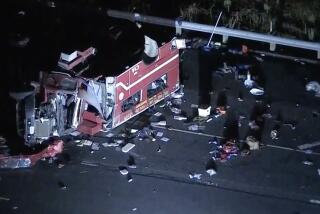Asiana crash: Death of girl hit by firetruck prompts safety review
Confirmation on Friday that one of the victims of the Asiana Airlines crash died after being run over by a rescue vehicle opened a new front into the investigation over what went wrong in the air disaster.
San Francisco County and San Mateo County officials acknowledged Friday that the victim, a 16-year-old Chinese girl, was alive on the tarmac when the vehicle struck her, giving her crushing injuries and internal hemorrhaging.
San Francisco fire chief Joanne Hayes-White told reporters Friday that it is believed the girl was struck by a specialized aircraft rescue firefighting vehicle that can go as fast as 70 mph and spray foam while en route to a plane.
Air safety experts said they could not remember a case in recent U.S. history of a passenger being fatally struck by rescuers and said it will require a significant reevaluation of how crews handle crashes.
The experts said rescuers at San Francisco International Airport acted with the best of intentions: They have been taught that a fire is the most dangerous aspect of a plane crash and that extinguishing it as quickly as possible should be the top priority.
But in this case, many Asiana passengers managed to exit the plane before the fire spread and were walking on the tarmac. It’s unclear how the victim, Ye Mengyuan, got to a space near the left wing of the plane.
Authorities say when she was found, she was covered in foam that was used to put out the fire.
It is unclear whether the teenager was covered in foam at the time of the collision. [Updated, 6:42 p.m.: A San Francisco Police Department spokesman said last week the girl was outside the plane and covered in fire-retardant foam when the fire truck “went over her.”]
Experts said fire engines start spraying foam on the fire even while the vehicles are still moving.
Tom Wieczorek, director of a first-responder training association in Washington, D.C., said the Asiana incident shows that officials need to look at the way rescuers approach crash sites.
Some ideas investigators might consider would to be equip trucks with infrared sensors that could detect body heat or to have spotters help drivers look for victims on the tarmac.
Wieczorek and others said that until recent years, rescuers typically wouldn’t encounter survivors on the tarmac because planes tended to explode during crash landings. But the development of fire-resistant materials in planes over the last two decades has increased the survivability of passengers in hard landings like the one at SFO.
“There will be a lot of second-guessing,” said Wieczorek, the director for the Center for Public Safety Management at the International City/County Management Assn.
He said that driving a firetruck on the way to a burning plane is very difficult.
“Your responders are being pulled in about 15 different directions. You’re looking for victims obviously first. ... You’re receiving radio messages and updates and deciding how you’re going to position your equipment,” he said. “And they’re beginning to spray foam designed to smother the fire.
“Everybody will look at it now with the ability to look at it outside of the chaos and say, ‘OK, what happened?,’ ” he continued. “It’s always easy to do. It’s much more different when you’re in the middle of that chaos.”
Even with a rethinking of rescue procedures, it’s possible that collisions with survivors will still occur, said Stephen Kilby, Miami International Airport division chief at Miami-Dade Fire Rescue.
“That’s one of the things that we try to prepare for in our training because we realize as the wreckage is scattered, people can unfortunately be scattered as well,” Kilby said. “We train for things like this, but sometimes, if something like that were to happen, I’m not sure that it’s avoidable.”
Kilby said the foam could easily conceal a person covered underneath it. The foam is needed to smother the flames.
“Now this foam … it’s almost like a bubble bath … you could easily lose something in the foam blanket,” he said. “This is a nightmare … We do train for it and even through the training, things are going to happen … sometimes situations are unavoidable.”
If a similar situation occurred at Miami International Airport, Kilby said investigators would “try and reconstruct what happened, just as we do with any of our other fire scenes” and would ask: “Was this a training issue? Was this an equipment issue? … There may be a lot of things.”
Hayes-White called the death of Ye a “tragic accident” and said in a news conference that the incident is still under investigation.
Ye, a Chinese student, died of “multiple blunt injuries that are consistent with being run over by a motor vehicle,” San Mateo County Coroner Robert J. Foucrault said Friday.
“She was alive when she received the injuries,” he said.
Ye was one of three passengers killed. Her body was found close to the aircraft’s left wing following the July 6 crash-landing at the airport, officials said.
Foucrault said Ye had “crushing injuries consistent with the motor vehicle” and internal hemorrhages. He said it is not clear how her body ended up near the plane’s wing and said it was “speculative” that she was thrown from the plane. She was on the ground when she was struck by the vehicle.
Hayes-White, surrounded by members of her command staff, said the coroner’s confirmation of Ye’s cause of death was difficult for her department.
“It was very hard to hear,” she said. “Devastating, heartbroken -- there are not a lot of words to describe how badly we feel, how sorry we feel for it.”
Hayes-White said initial reports indicated there was a “blanket” of fire-retardant foam in the area where Ye’s body was found.
Firefighters responding to the crash came upon a “very volatile, dangerous situation,” Hayes-White said.
Debris from the crash was strewn about the runway, and fuel leaked from the plane, she said. When they arrived, the plane was still engulfed in flames, she said.
“It was a difficult, challenging scene,” she said.
The department will evaluate its protocols and see how it can improve its responses to such scenes, she said.
“Everyone is very emotional from this incident,” Hayes-White said of her department. “Getting the news yesterday has made it very difficult ... we go to work every day to save lives. Many lives were saved July 6 ... however, I don’t want to take away from the loss of the three lives.”
Hayes-White said her department made a “valiant effort” to save lives. The San Francisco Police Department and National Transportation Safety Board are investigating the incident, she said.
There were numerous emergency vehicles in the area, and neither Hayes-White nor Foucrault would comment on whether Ye was struck by multiple vehicles, saying that was part of the police investigation.
Hayes-White would not comment on whether the department could face civil or criminal liability for Ye’s death, saying, “I’m not a legal expert.”
ALSO:
Young immigrants to risk detention at border to protest deportations
Katherine Jackson: Tell me ‘what really happened to my son’
Mountain fire burns close to resort town; 6,000 evacuated
Twitter: @ronlin | @haileybranson | @aribloomekatz
More to Read
Sign up for Essential California
The most important California stories and recommendations in your inbox every morning.
You may occasionally receive promotional content from the Los Angeles Times.












